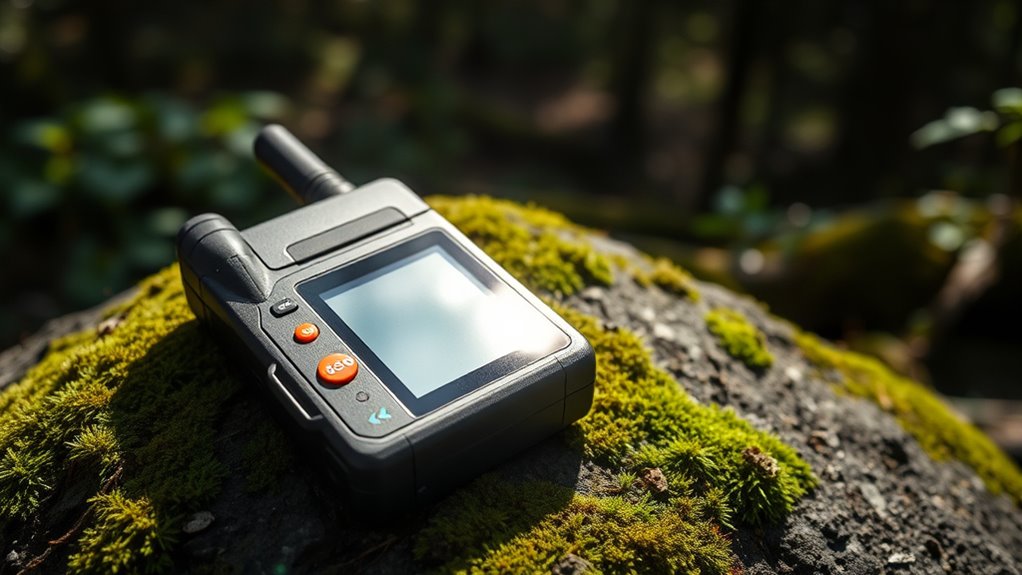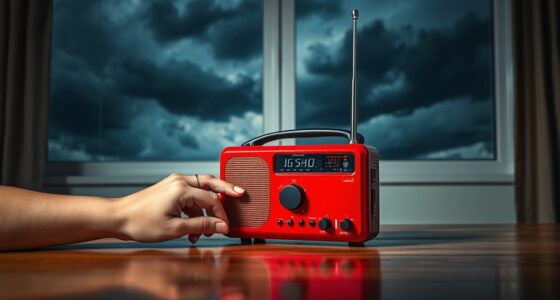Satellite messengers and personal locator beacons are essential tools for staying connected and safe during outdoor adventures in remote areas. They allow you to send SOS signals, alert rescue teams, and transmit your exact location via satellite when cell service isn’t available. These devices often include navigation features to help you find your way back and avoid hazards. If you want to discover more about how these devices protect outdoor enthusiasts, keep exploring your options.
Key Takeaways
- Satellite messengers and personal locator beacons enable emergency communication in remote areas without cell service.
- They transmit GPS location and send distress signals or predefined messages to rescue teams.
- These devices often include navigation features like route tracking, waypoints, and terrain maps.
- Designed for durability and long battery life, they withstand harsh outdoor conditions.
- They provide outdoor enthusiasts with safety, peace of mind, and reliable connectivity during adventures off the grid.

When you’re exploring remote areas or engaging in outdoor adventures, having reliable communication devices can be a lifesaver. Satellite messengers and personal locator beacons (PLBs) are essential tools that guarantee you stay connected and safe, no matter how far off the grid you go. These devices are designed for emergency signaling, allowing you to send distress signals to rescue services or loved ones when cell service isn’t available. Their ability to transmit your location via satellite makes them invaluable in situations where traditional communication methods fail. Plus, many models also incorporate outdoor navigation features, helping you find your way through unfamiliar terrain even when you’re cut off from conventional GPS signals or maps.
When an emergency strikes, quick and clear signaling can make all the difference. Satellite messengers allow you to send predefined messages or SOS signals at the push of a button, alerting rescue teams to your exact location. This rapid emergency signaling capability is essential if you’re injured, lost, or facing dangerous weather conditions. Having this peace of mind means you don’t have to worry about your safety when venturing into remote wilderness, mountain ranges, or deep forests. Instead, you can focus on your adventure, confident that help is just a satellite message away.
In addition to emergency signaling, these devices excel at outdoor navigation. Many satellite messengers come equipped with GPS functionality, enabling you to track your route, mark waypoints, and navigate back to your starting point. This feature is particularly useful when you’re venturing into unfamiliar terrain, where traditional maps might not be sufficient or reliable. With real-time positioning, you can plan your route more effectively, avoid hazards, and guarantee you stay oriented even if visibility drops or landmarks are scarce. Some devices also offer topographical maps and routes, giving you detailed terrain information that enhances your navigation skills. Furthermore, these devices often include durable design features to withstand the rigors of outdoor environments, ensuring they remain functional in harsh conditions.
Another advantage is that satellite messengers are often lightweight and user-friendly, making them easy to carry without adding unnecessary bulk to your gear. They typically have long-lasting batteries, so you can rely on them for extended periods, even during multi-day trips. Whether you’re crossing vast deserts, mountain peaks, or dense forests, these devices provide a crucial link to safety and navigation. They’re a smart investment for anyone who loves outdoor adventures, guaranteeing that no matter how remote your location, you’re never truly alone.
Frequently Asked Questions
What Is the Battery Life of Different Satellite Emergency Devices?
You’ll find that battery longevity varies across satellite emergency devices, typically ranging from a few days to several weeks depending on usage and power management. Devices with efficient power management features, like automatic shut-off or low-power modes, help prolong battery life. To maximize longevity, prioritize regular charging, minimize unnecessary transmissions, and understand your device’s battery capacity. Staying aware of these factors ensures you’re prepared when emergencies arise.
How Do Satellite Messengers Work in Remote Areas Without Cell Service?
In remote areas without cell service, satellite messengers work by using satellite signal penetration to connect with orbiting satellites. When you send a message or distress signal, the device transmits data directly to these satellites, bypassing cell towers. Its durability guarantees it withstands harsh conditions, so you can rely on it in tough environments. This enables you to stay connected and send your location, even where cell coverage is nonexistent.
Are There Subscription Fees for Using Personal Locator Beacons?
Yes, there are subscription costs for using personal locator beacons. You’ll typically pay a yearly fee that covers device maintenance, satellite network access, and emergency services. These costs vary depending on the provider and plan you choose. Keep in mind that maintaining your device by updating batteries or firmware is essential for reliable operation. Be sure to compare plans to find one that fits your needs and budget.
What Is the Global Coverage Range of These Devices?
Think you’re safe with a satellite device? Think again. These gadgets boast impressive global coverage, thanks to satellite network coverage that spans most of the Earth’s surface. While they’re reliable, remember that emergency signal accuracy can vary, especially in remote areas. So, no matter where you wander, you’ll have some level of connectivity—just don’t expect flawless precision every time. Stay prepared, and don’t get too cocky.
How Reliable Are Satellite Communications During Extreme Weather Conditions?
During extreme weather conditions, satellite communications can be less reliable due to weather interference and weakened satellite signal strength. You might experience delayed or failed transmissions when storms, heavy rain, or snow occur. However, these devices are generally designed to function in challenging environments, so while reliability can dip, they often still provide vital connectivity. Keep in mind that in severe weather, it’s wise to have backup plans for communication.
Conclusion
Now that you know the importance of satellite messengers and personal locator beacons, imagine being caught in a situation where help is just out of reach. Will your device be ready to alert others, or will you be left wondering what could have been? The choice is yours—equip yourself wisely and stay prepared. Because in the wilderness, help can arrive in an instant, or not at all. Are you ready for what’s next?









